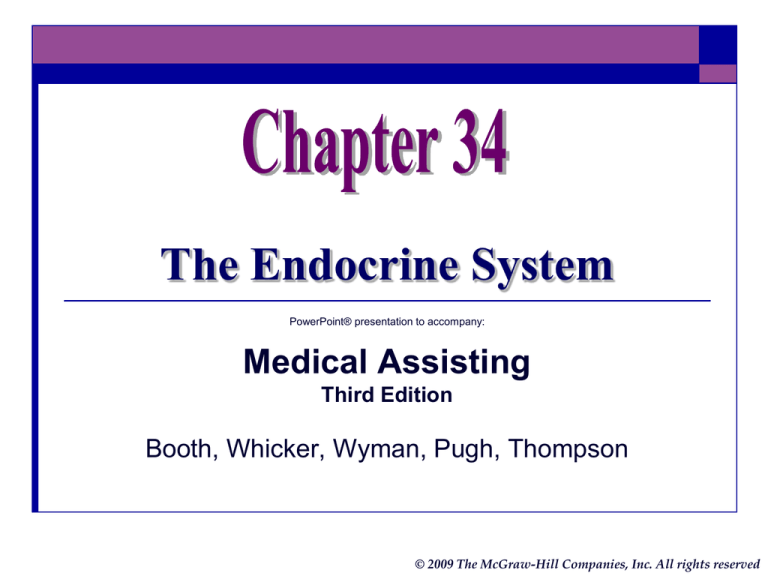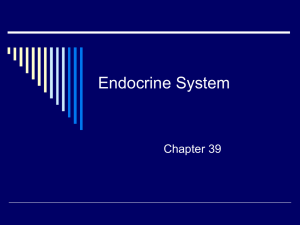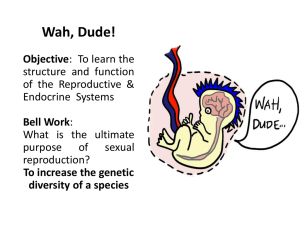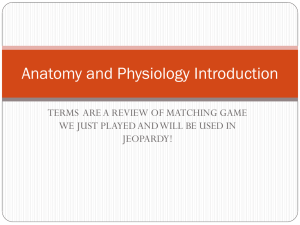
The Endocrine System
PowerPoint® presentation to accompany:
Medical Assisting
Third Edition
Booth, Whicker, Wyman, Pugh, Thompson
© 2009 The McGraw-Hill Companies, Inc. All rights reserved
34-2
Learning Outcomes
34.1 Define the term endocrine glands.
34.2 Describe the general functions of the endocrine
system.
34.3 Define the term hormone.
34.4 Explain the difference in hormone control by
positive and negative feedback loops.
© 2009 The McGraw-Hill Companies, Inc. All rights reserved
34-3
Learning Outcomes (cont.)
34.5 Describe the locations of the hypothalamus,
pituitary gland, pineal body, thyroid gland,
parathyroid glands, adrenal glands, pancreas,
thymus, and gonads.
34.6 List the hormones released by the pituitary gland
and give the functions of each.
34.7 List the hormones released by the thyroid gland
and parathyroid glands and give the functions of
each.
© 2009 The McGraw-Hill Companies, Inc. All rights reserved
34-4
Learning Outcomes (cont.)
34.8 List the hormones released by the adrenal glands
and give the functions of each.
34.9 List the names of the endocrine cells of the
pancreas, the hormones released by them, and the
function of each hormone.
34.10 List the hormones released by the pineal body,
thymus, and gonads, and give the functions of
each.
© 2009 The McGraw-Hill Companies, Inc. All rights reserved
34-5
Learning Outcomes (cont.)
34.11 Name the hormones produced by the kidneys and
heart, listing which organ produces the hormone,
and the hormone’s function.
34.12 Describe stressors and their effect on the body.
34.13 Describe the causes, signs and symptoms, and
treatment of various endocrine disorders.
© 2009 The McGraw-Hill Companies, Inc. All rights reserved
34-6
Introduction
The endocrine system includes the organs of the
body that secrete hormones directly into body fluids
such as blood
Regulates chemical reaction in cells and therefore control
functions of the organs, tissues, and other cells
bloodstream
to
Glands
into
secrete
hormones
target tissues
© 2009 The McGraw-Hill Companies, Inc. All rights reserved
34-7
Hormones
Endocrine glands
Ductless
Release hormones
Directly into target tissues
Into bloodstream to be carried to target tissues
Hormones – chemicals secreted by a cell that
affect the functions of other cells
© 2009 The McGraw-Hill Companies, Inc. All rights reserved
34-8
Hormones (cont.)
Many are derived from steroids that easily
cross the cell membrane
Examples of steroid hormones
Estrogen
Progesterone
Testosterone
Cortisol
hormones
© 2009 The McGraw-Hill Companies, Inc. All rights reserved
34-9
Hormones (cont.)
Nonsteroidal hormones
Made of amino acids or
proteins and cannot cross the
cell membrane easily
Bind to receptors on the
surface of the cells
G-protein – activated by the
hormone-receptor complex
Activates enzymes inside
cell
Prostaglandins
Local, or tissue, hormones
Derived from lipid molecules
Do not travel in the
bloodstream
Target tissues are located
close by
Produced by organs such as
Kidneys
Heart
Stomach
Uterus
Brain
© 2009 The McGraw-Hill Companies, Inc. All rights reserved
34-10
Negative and Positive
Feedback Loops
Control hormone levels
Negative feedback loop
Hormone release stops in response to decrease in
stimulus
Stimulus (eating) raises blood glucose levels
Pancreas releases insulin in response to elevated blood
glucose
Blood glucose decreases as it is used by the body or
stored in the liver
Insulin release stops as blood glucose levels normalize
© 2009 The McGraw-Hill Companies, Inc. All rights reserved
34-11
Negative and Positive
Feedback Loops (cont.)
Positive feedback loop
As long as stimulus is present, action of hormone
continues
Infant nursing at mother’s breast stimulates
hypothalamus stimulates posterior pituitary
Oxytocin released stimulates milk production and
ejection from mammary glands
Milk release continues as long as infant continues to
nurse
© 2009 The McGraw-Hill Companies, Inc. All rights reserved
34-12
Apply Your Knowledge
Match the following:
ANSWER:
___
E Chemicals that effect cell function A. Nonsteroidal hormone
B Easily cross cell membranes
___
B. Steroidal hormone
A Made of amino acids
___
C. G-protein
D Target nearby cells
___
D. Prostaglandins
___
C Activated by hormone-receptor
complex
E. Hormones
___
A Cannot cross cell membranes easily
B Estrogen and cortisol
___
© 2009 The McGraw-Hill Companies, Inc. All rights reserved
34-13
Hypothalamus
Hormones
Oxytocin
Antidiuretic hormone (ADH)
Hormones transported to the posterior
pituitary for storage
Directs posterior pituitary to release hormones
Glands
© 2009 The McGraw-Hill Companies, Inc. All rights reserved
34-14
Pituitary Gland
Controlled by the hypothalamus
Located at the base of the brain
Protected by a bony structure called the sella turcica
The optic chiasm is located just above the pituitary gland
Carries visual information to the brain for interpretation
Two lobes
Anterior lobe
Posterior lobe
Glands
© 2009 The McGraw-Hill Companies, Inc. All rights reserved
34-15
Pituitary Gland (cont.)
Growth hormone
Stimulates increase in size
of muscles and bones
Luteinizing
Prolactin Stimulates milk
production
Anterior
Lobe
Females: stimulates ovulation
and estrogen production
Males: stimulates testosterone production
Adrenocorticotropic
Stimulates the adrenal cortex
to release its hormones
Thyroid-stimulating
Stimulates the thyroid
gland to release its
hormones
Follicle-stimulating
Females: stimulates estrogen
production and maturation of the ova
Males: stimulates sperm production
© 2009 The McGraw-Hill Companies, Inc. All rights reserved
34-16
Pituitary Gland (cont.)
Oxytocin
Posterior
Lobe
Antidiuretic hormone (ADH)
Stimulates the kidneys to
conserve water
Females: causes
contraction of the
uterus and ejection of
breast milk
Males: stimulates
contraction of the
prostate and vas
deferens during
sexual arousal
© 2009 The McGraw-Hill Companies, Inc. All rights reserved
34-17
Apply Your Knowledge
Match the following:
ANSWER:
D,
___
E Stored in posterior pituitary
A. Follicle-stimulating hormone
___
B Milk production
B. Prolactin
D,
___
E Produced by hypothalmus
C. Luteinizing hormone
___
A Stimulates sperm production
D. ADH
___
A Maturation of ova
E. Oxytocin
___
C Stimulates ovulation
___
D Conservation of water
___
C Production of testosterone
___
E Contraction of uterus
Super!
© 2009 The McGraw-Hill Companies, Inc. All rights reserved
34-18
Thyroid Gland and
Parathyroid Glands
Thyroid Gland
Located below the larynx
Divided into follicles that store some of the hormones
Major hormones
T3 T4
Stimulate protein synthesis and
increase cellular energy
production
Lowers blood calcium levels
by activating osteoblasts that
Glands
build new bone tissue
© 2009 The McGraw-Hill Companies, Inc. All rights reserved
34-19
Thyroid Gland and
Parathyroid Glands (cont.)
Parathyroid glands
Four located on the posterior surface of the
thyroid gland
Secrete parathyroid hormone (PTH)
Agonist to calcitonin by raising blood calcium levels
through activation of osetoclasts (dissolve bone)
As bone dissolves, calcium levels in blood increase
Glands
© 2009 The McGraw-Hill Companies, Inc. All rights reserved
34-20
Apply Your Knowledge
True or False:
ANSWER:
__
T Thyroid hormones stimulate protein synthesis.
Thyroid follicles store
__
F The thyroid gland does not store hormones. some hormones.
__
F PTH activates osteoblasts.
PTH activates osteoclasts.
__ Calcitonin increases cellular energy production.
F
Thyroid hormone
increases cellular
energy production.
T
__ The four parathyroid glands are located on the thyroid gland.
__
T Calcitonin lowers blood calcium levels.
© 2009 The McGraw-Hill Companies, Inc. All rights reserved
34-21
Adrenal Glands
Located on top of each kidney
Divided into the adrenal medulla and adrenal cortex
Adrenal medulla
Central portion
Hormones
Epinephrine
Norepinephrine
Same effects as sympathetic nervous system
Glands
© 2009 The McGraw-Hill Companies, Inc. All rights reserved
34-22
Adrenal Glands (cont.)
Adrenal cortex
Outermost portion
Secretes many hormones, but main ones are
Aldosterone
Stimulates body to retain sodium and water
Important in maintaining BP
Cortisol
Released when stressed
Decreases protein synthesis, resulting in slowed tissue repair
Decreases inflammation
© 2009 The McGraw-Hill Companies, Inc. All rights reserved
34-23
Apply Your Knowledge
Match the following:
ANSWER:
____
B, D Adrenal medulla
A. Cortisol
C Sodium retention
____
B. Epinephrine
A Decreases inflammation
____
C. Aldosterone
B, D Sympathetic effects
____
D. Norepinephrine
____
C Maintains blood pressure
____
A Released during stress
A, C Adrenal cortex
____
Excellent!
© 2009 The McGraw-Hill Companies, Inc. All rights reserved
34-24
Pancreas
Located behind the
stomach
Both exocrine gland and
endocrine gland
Exocrine – secretes
digestive enzymes into a
duct leading to the small
intestine
Endocrine – secretes
hormones into
bloodstream
Glands
© 2009 The McGraw-Hill Companies, Inc. All rights reserved
34-25
Pancreas (cont.)
Islets of Langerhans secrete hormones into
bloodstream
Alpha cells secrete glucagon
Beta cells secrete insulin
Blood glucose
concentrations
Protein synthesis
Blood glucose
concentrations
Protein synthesis
© 2009 The McGraw-Hill Companies, Inc. All rights reserved
34-26
Apply Your Knowledge
What are the effects of insulin and glucagon?
ANSWER: Insulin decreases blood glucose concentration
and increases protein synthesis.
Glucagon does just the opposite. It increases blood
glucose and decreases protein synthesis.
Yippee
!
© 2009 The McGraw-Hill Companies, Inc. All rights reserved
34-27
Other Hormone-Producing Organs
Pineal body
Small gland
Located between
cerebral hemispheres
Melatonin
Regulates circadian
rhythms
May play a role in
onset of puberty
Thymus gland
Located between
lungs
Thymosin
Promotes
production of
T lymphocytes
Glands
© 2009 The McGraw-Hill Companies, Inc. All rights reserved
34-28
Other Hormone-Producing
Organs (cont.)
The gonads
Ovaries
Gastrin
Secretin
Cholecystokinin
Heart
Testosterone
Stomach
Small intestine
Estrogen
Progesterone
Testes
Atrial natriuretic
peptide – regulates BP
Kidneys
Erythropoietin –
stimulates blood cell
production
Glands
© 2009 The McGraw-Hill Companies, Inc. All rights reserved
34-29
Back
© 2009 The McGraw-Hill Companies, Inc. All rights reserved
34-30
Apply Your Knowledge
Match the following:
ANSWER:
D Between lungs
___
A. Pineal body
A Melatonin
___
B. Heart
G Estrogen/testosterone
___
C. Kidneys
F Gastrin
___
D. Thymus gland
E Secretin
___
E. Small intestine
C Erythropoietin
___
F. Stomach
B Atrial natriuetic peptide
___
G. Gonads
D Thymosin
___
E Cholecystokinin
___
© 2009 The McGraw-Hill Companies, Inc. All rights reserved
34-31
The Stress Response
Stressor
Any stimulus that
produces stress
Types
Physical factors
Psychological
factors
Positive stimuli
© 2009 The McGraw-Hill Companies, Inc. All rights reserved
34-32
The Stress Response (cont.)
Physiologic response to stress caused by
hormone release
General stress syndrome
Increased heart rate, respiratory rate, and BP
Increase in glucose and fatty acids in blood, which
leads to weight loss
Increase in cortisol if stress prolonged
Decreased body repair
Susceptibility to illness
© 2009 The McGraw-Hill Companies, Inc. All rights reserved
34-33
Apply Your Knowledge
Match the following: ANSWER:
___
A Extreme heat
A. Physical stress
___
B Death of friend
B. Psychological stress
___
A Fractured leg
C. Positive stimulus
___
C Wedding
___
B Exam
___
B Hearing an explosion nearby
___
C “A” on an exam
___
A Flu
___
B Car stolen
© 2009 The McGraw-Hill Companies, Inc. All rights reserved
34-34
Common Diseases and Disorders
Disease/Disorder
Acromegaly
Description
Too much growth hormone produced in adults;
enlargement of bones and thickened skin
Addison’s disease Adrenal gland fails to produce enough
corticosteroids
Cretinism
Extreme form of hypothyroidism present prior
to or soon after birth
Cushing’s disease Hypercortisolism; over-production of cortisol
Diabetes insipidus Kidneys fail to reabsorb water, resulting in
excessive urination; hyposecretion of ADH
© 2009 The McGraw-Hill Companies, Inc. All rights reserved
34-35
Common Diseases and Disorders (cont.)
Disease/Disorder
Diabetes mellitus
Description
Chronic disease characterized by elevated
blood glucose levels
Type I
Insulin-dependent diabetes mellitus; usually develops
in childhood
Noninsulin-dependent diabetes mellitus; primarily in
adults but increased incidence in teens
Occurs during pregnancy; usually temporary
Type II
Gestational
Dwarfism
Too little growth hormone (somatotropin)
produced during childhood
© 2009 The McGraw-Hill Companies, Inc. All rights reserved
34-36
Common Diseases and Disorders (cont.)
Disease/Disorder Description
Gigantism
Too much growth hormone produced during
childhood
Goiter
Enlargement of thyroid gland, causing
swelling in neck; deficiency of iodine in diet
Grave’s disease
Hyperthyroidism; antibodies attach to thyroid
gland, causing it to produce too much thyroid
hormone
Myxedema
Thyroid gland produces inadequate amounts of
thyroid hormone; common in females over 50
© 2009 The McGraw-Hill Companies, Inc. All rights reserved
34-37
Correct!
Apply Your Knowledge
True or False:
ANSWER:
in an adult
___
F Acromegaly develops as a result of too much growth hormone in a child.
T In diabetes insipidus, the kidneys fail to reabsorb water.
___
___
T Too little growth hormone in childhood results in dwarfism.
___
F Myxedema is the result of hyperthyroidism.
hypothyroidism
___
T Addison’s disease is the result of too little corticosteroid.
___
F Cushing’s disease is the result of too little ACTH.
too much ACTH
___
F Cretinism is an extreme form of hyperthyroidism present at birth.
hypothyroidism
© 2009 The McGraw-Hill Companies, Inc. All rights reserved
34-38
In Summary
The organs of the
endocrine system
secrete hormones
directly into blood and
other body fluids.
Hormones secreted by
the endocrine system
control the functions of
other cells.
Endocrine organs
Hypothalamus
Pituitary gland
Thyroid gland
Parathyroid glands
Adrenal glands
Pancreas
Pineal body
Thymus gland
Gonads, stomach small
intestine, heart, kidneys
© 2009 The McGraw-Hill Companies, Inc. All rights reserved
34-39
Its not stress that
kills us, it is our
reaction to it.
~ Hans Selye
© 2009 The McGraw-Hill Companies, Inc. All rights reserved









